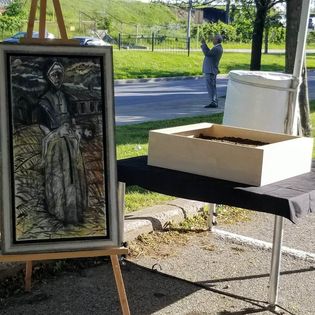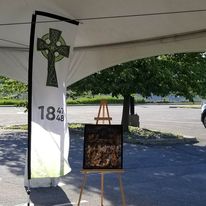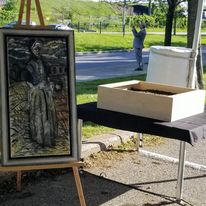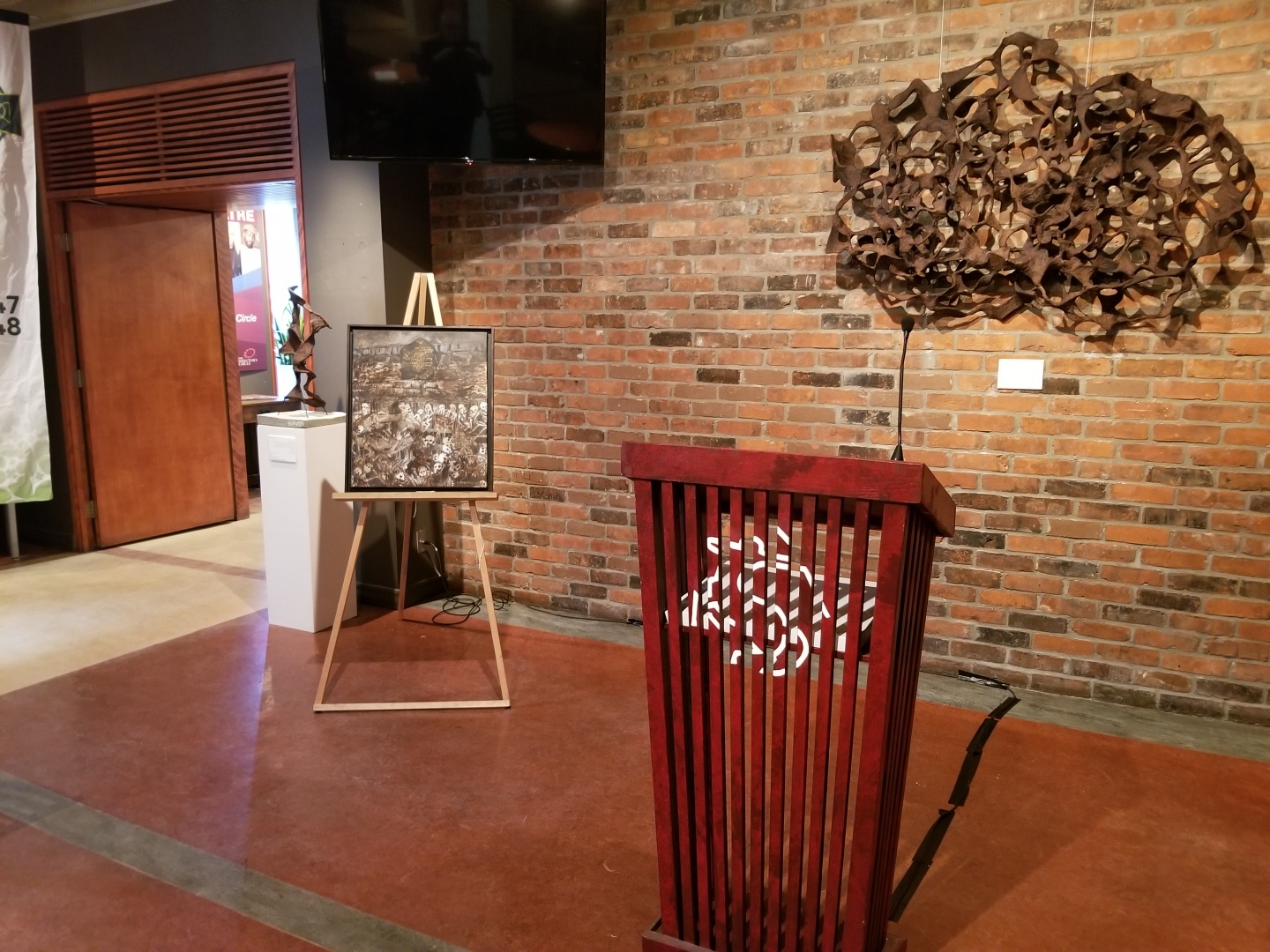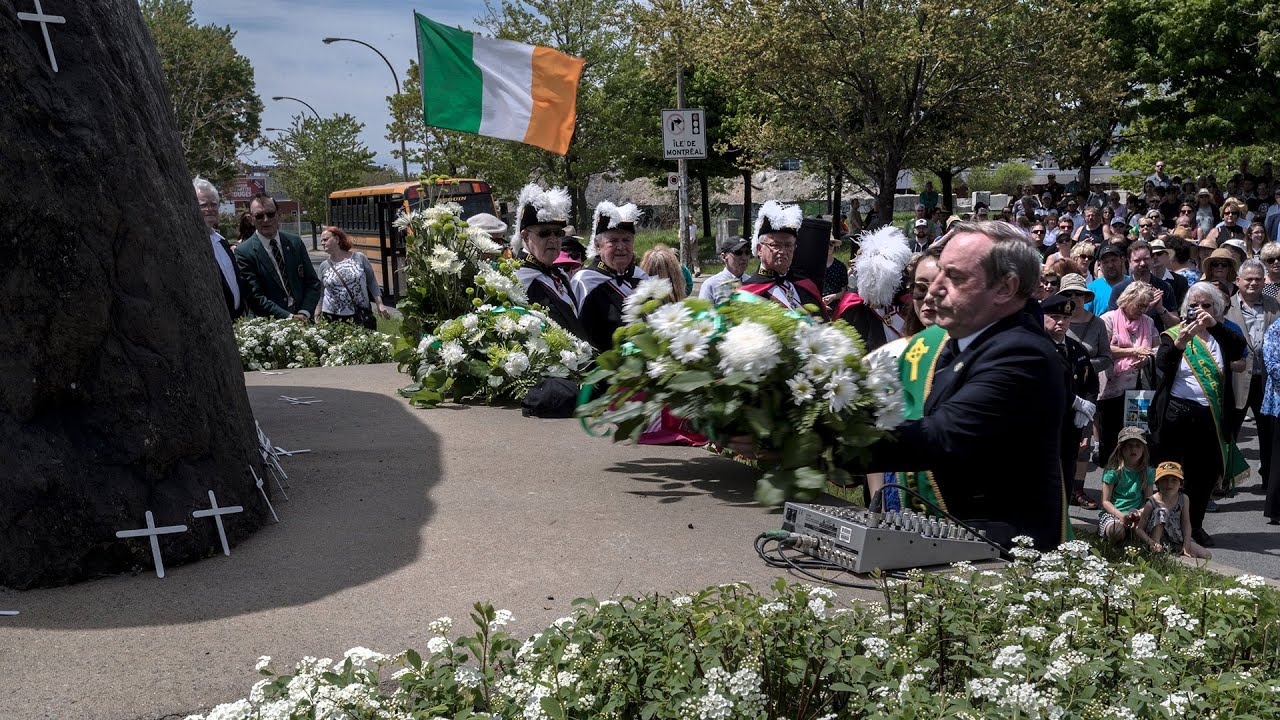Irish Commemorative Stone (Black Rock)Montréal, Québec
The gatherings at the Irish Commemorative Stone (Black Rock) are typically referred to as “Memorials”. In fact, since the very first gathering in the late 1800’s they have been about awareness:
1847: The hottest, most humid summer in memory. Roughly 100,000 sick and dying Irish arrive on the shores of Windmill Point in Montreal – a city with a population of 50,000 – after getting a clean bill of health from the doctors at the Grosse Île quarantine station located 50 kilometers from Quebec City.
Organized care was non-existent. The newly opened St. Patrick’s Church at the top of the hill refused recognize the suffering, Irish, claiming any direct association with the site may jeopardize its hard-fought battle for legitimacy. Lazarettos, known as fever sheds, were hastily erected to provide at least some basic shelter from the elements.
The moribund and cadavers crowded along Montreal’s wharf quays produced an inescapable stench across the island of Montreal.
Grey Nuns of Montreal Mother Superior Forbes-McMullen is said to have “conceived a bright desire to rush to the relief of this misery with her girls” and, accordingly, “convinced them to combat in a new field of sacrifice.” Others rushed in. Common, everyday people armed only with an unshakeable need to do what’s right, brought food, water, and clothes. The Mohawk Nation supplied food and what little money they had – they shared. English, French, Catholic, Protestant, Jewish, even British soldiers picked up the mantle of care. Hundreds of Irish orphans were adopted by local families. If the children were old enough to know their name, they would keep it. If not, the they would take the name of their new family. It is estimated that 43% of all Quebecers have Irish roots.
Mayor of Montreal, John Easton Mills who was not Irish, Catholic, or Canadian caught Typhus and died after insisting to help when his day at City Hall was done.
When it was over 6,000 men, women and children lied in an unmarked mass grave in Point St. Charles on the shores of the mighty Saint Lawrence River; the land donated and consecrated by the Grey Nuns. In an interview at the turn of the 19th century Sister Reid who survived the 1847 fever sheds and standing at the cemetery in the weeds and mud with the grave mounds still visible lamented, “I wish we did more to commemorate the site and protect them.”
1859: While working on the construction of the Victoria Bridge that would link the Island of Montreal to the South Shore Irish workers began to uncover human remains. They refused to continue. Taking advantage of the tight construction schedule (the bridge was due to open in August of 1860) the Irish workers negotiated for a “Memorial” at the site. A mud covered 40-ton granite boulder pulled from the St. Lawrence like a rotting tooth was placed at the Southeast corner of the Cemetery to remain the guardian for “As long as winds blow, and rivers flow” Dubbed the “Irish Commemorative Stone,” its inscription would become a lightning rod for the Ancient Order of Hibernians for more than a century and a half:
“To Preserve from Desecration the Remains of 6000 Immigrants Who died of Ship Fever A.D. 1847-48
This Stone is erected by the Workmen of Messrs. Peto, Brassey and Betts Employed in the Construction of the Victoria Bridge A.D. 1859″
No mention of Irish was permitted.
The Irish Commemorative Stone as well as the Cemetery would remain under the auspices of the Anglican Church.
1868: During a spring visit to the Cemetery the Ancient Order of Hibernians stood aghast at the condition of the site, “A place that has not felt human steps for years.” A pledge was made that we, the Ancient Order of Hibernians, would assume the promise made by the Stone and Preserve from Desecration the Remains of 6000. Nor would we let the 6,000 be forgotten. An open-air requiem mass and memorial ceremony was organized immediately. That memorial ceremony, now known as the Walk to the Stone, continues ……
1895: Just three years after formally incorporating the first AOH division in Canada (Hochelaga – Division 1) the AOH approached the Anglican Church with an offer to purchase the land and assume the care of the Cemetery and the souls in perpetuity – including adding a stone wall perimeter with Celtic crosses at the four corners, and a shamrock adorned iron entrance. The Anglican Church refused the offer without explanation.
1898: Under cover of darkness on Christmas eve the Grand Truck Railway, seeking land to increase trackage, loaded the Stone on a railcar, unceremoniously dumping it alongside the Lachine Canal a few blocks away.
On Christmas morning the AOH mobilized the Irish Community in what would become a decade plus long legal battle to return the Stone to its rightful place at the head of the Cemetery in 1911. Unfortunately, using the newly enacted Canadian Railway Act, the Grand Truck Railway was able to secure 70% of the Cemetery to construct their track. Despite a nation-wide writing campaign by the AOH, the deal was sealed.
1964: In preparation for the World Exposition (Expo 67) in Montreal, Bridge Street, which passed on the East side of the Cemetery needed to be widened and straightened to accommodate the expected increase in traffic volume. The Stone stood directly in the path. The Irish Commemorative Stone committee was formed comprised of the AOH, United Irish Societies of Montreal and the St. Patrick’s Society to address the issue.
Incredulously, the first solution offered by the committee was to remove the Stone to another location and any remains be “disposed of in a suitable manner.” Frank Rooney of the AOH, and Don Pigeon of the UIS refused to entertain the option. The AOH insisted that the site not be altered nor the Stone moved, but that Bridge Street be totally reconfigured. Unable to reach an agreement within the commitee, the city was forced to split Bridge Street around the Stone, further encroaching on the Cemetery.
2007: With the land around the Stone now an industrial wasteland and rumors of a new baseball stadium in the air, the AOH resurrected attempts to purchase the Cemetery and the 10.5 acres surrounding it to create a Memorial space to help protect the sanctity of the Cemetery and the 6,000 buried there by telling the incredible story of 1847 and the heroes that gave comfort to the sick and dying.
2014: The AOH incorporates the Black Rock Montreal Irish Monument Park Foundation (The “Park Foundation”) to increase grass roots community involvement and eventually manage the completed Memorial.
2017: Hydro-Quebec purchased the 10.5 acres, but donates 3.65 acres for the Memorial. A tripartite partnership comprised of the “Park Foundation”, Hydro-Quebec and the City of Montreal. The Memorial is on schedule for completion in 2028.
2019: A 37’ diameter caisson is inserted into the southwestern most part of the Cemetery down to bedrock at a depth of 58’. Three archaeologists excavate the soil inch by inch. Fourteen remains are uncovered – two adults and twelve children in ages ranging from six-months to fifteen years. DNA research continues and is being shared with 165 Workhouses in Ireland who are also doing DNA research.
2022: A local micro-brewery markets a alcohol product using the name, image and inscription from the Irish Commemorative Stone. The3 AOH has the production ceased. .
2022: The digital Museums of Canada – the country’s preeminent repository of on-line virtual exhibits – approved the AOH grant for the exhibit, “Remembering Montreal’s Famine Irish”. It will tell the amazing story of 1847 in the words of the 6,000………
Their voices never again to be silenced.


